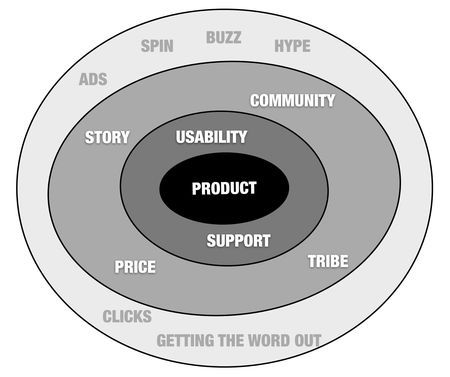Metail® – The Virtual Fitting Room
In the early 2000s, with the advent of online commerce, many high street fashion shops have taken a serious blow and closed their doors. The brands that were quick to perform a change in direction and moved their presence online with e-commerce shops managed to maintain brand awareness and keep their foothold on the market.
Today having an online shop is not enough. To increase sales and attract new customers, it’s good to offer discounts and other incentives but so do most fashion brands. What do you do to stand out among your competitors?
![]()
Learn more: Grow Your Business with These 6 Tech-Powered Trends
![]()
Well, a good place to start is to know your customers’ pain points. Women love to spend time shopping, it’s one of our hobbies. But shopping has the following drawback: we get tired of spending hours on end in the shop changing room. We also love shopping online, but how can we make sure the clothes fit us right if we cannot try them on?
Is your brand looking to solve this problem?
Metail® provides you with an innovative solution.
Metail® – A Virtual Fitting Room

Metail® is a virtual fitting room service for fashion retailers. It allows your customers to create a 3D photo-realistic model of themselves from just two uploaded photos, in only a few minutes.
Once the 3d model is ready, they can then try on clothes, see how they fit and create and share their looks.
Once a customer has made their model, they can login to their Metail® profile with any partner retailer using the service.
It’s all about enhanced online shopping experience through technology.
Metail® is powered by its own recommendation engine based on a machine learning algorithm and 3D visualisation technology.
The company was started in 2008 by CEO and Founder Tom Adeyoola who wanted to help his girlfriend find well-fitting clothes she liked without spending hours in the shop’s changing rooms.
Since then, Metail® raised $32.4M in funding, filed patents with 9 granted and 22 pending and built a highly skilled team dedicated to solving the problem of finding the right fit when shopping online.
Metail® aims to become the global body shape and visualisation experts.
What problems fashion retail customers have that the company addresses through its platform?
Metail® addresses the following customer problems:
- Every body is unique, so finding the perfect fit can be challenging;
- Inconsistent clothing sizes;
- Complicated sizing charts;
- High returns and unhappy consumers.
Benefits for fashion retail customers:
- Shoppers receive personalised size advice and style recommendations;
- Increased brand trust and brand awareness;
- It can change the way people view body image and clothing;
- Empowers users to dress for their own personal shape rather than for the projection of the ‘ideal’ form;
- Offers an enhanced online experience your customers will love;
- Limit waste;
- Save time and money.

Benefits for your retail fashion brand:
- Up to 22% uplift in sales;
- Increased engagement and adoption rates of up to 76%;
- Expand your knowledge about your shoppers with tech-driven insights;
- Customers spend up to 5x longer time on the site;
- Manage inventory efficiently;
- Streamline your supply chain;
- Deliver a seamless online experience on the web, mobile and tablet;
- Continuously learning from new data every day (7.2 billion data points – and counting).
Awards and recognitions:
- Shortlisted for BAFTA Television Craft Award | Digital Creativity in 2014 for ‘Take Over the Makeover’;
- Shortlisted for BT Retail Week Technology Award 2014 and 2015;
- Wins 2014 Decoded Hackathon for creating ‘Loop’ app;
- Wins the 2015 IBM Commerce Ecosystem Technology Innovator of the Year at IBM Amplify;
- Wins 2015 Digital Coalition of the Year with House of Holland at the inaugural Decoded Fashion Futures Awards;
- In 2017 it is accepted in the Microsoft Accelerator program, a global initiative empowering entrepreneurs around the world. The company was awarded US$500,000 worth in Azure Cloud credits;
- Wins a 2017 Techie award for Retail & Innovator of the Year;
- One of the honorees of the Maserati 100 list as an industry disruptor;
- In 2018, Metail’s CEO, Tom Adeyoola was named amongst “Ones to Watch” in Top 50 Most Ambitious Business Leaders, supported by The Telegraph.
Join the Conversation
We’d love to hear what you have to say.
Get in touch with us on Facebook Group and Twitter.
Nelson Mandela’s life in 19 landmarks
On July 18 the world celebrates The Nelson Mandela International Day.
Here are 19 landmarks in Nelson Mandela’s life to help you learn more about the legacy of this South African anti-apartheid revolutionary, political leader, and philanthropist.
Nelson Mandela’s life in 19 landmarks
1. Nelson Madiba Mandela
His name is Rolihlahla Madiba Mandela. His father was Nkosi Mphakanyiswa Gadla Mandela, principal counsellor to the Acting King of the Thembu people, Jongintaba Dalindyebo.
In primary school, his teacher, Miss Mdingane, gives him the name Nelson, in accordance with the custom of giving all school children “Christian” names. Later in life, he was mostly called by his Xhosa name, Madiba.
2. He was Xhosa
He was a Xhosa. The Xhosas are an ethnic group of approximately 8 million people and the Xhosa language is South Africa’s second-most-populous home language, after the Zulu language.

Nelson Mandela / time.com
3. He established South Africa’s 1st black law firm
Together with Oliver Tambo, he establishes South Africa’s first black law firm, Mandela & Tambo in 1952 after he received his diploma in law on top of his BA. His firm specialized in cases resulting from the post-1948 apartheid legislation.
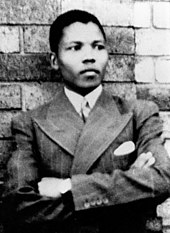
Nelson Mandela / wikipedia.org
4. Politically involved as a nationalist leader
Starting with 1942 Mandela became increasingly politically involved. He joined the African National Congress in 1944 and helped to form the ANC Youth League. He leads various campaigns of civil disobedience against unjust laws which required nonwhites to carry documents (known as passes, passbooks, or reference books) authorizing their presence in areas that the government deemed “restricted” (i.e., generally reserved for the white population).
5. The Freedom Charter
In 1955 he was involved in drafting the Freedom Charter, a document calling for nonracial social democracy in South Africa. The document was a response to an increasingly repressive government. It held demands such as “Land to be given to all landless people”, “Living wages and shorter hours of work”, “Free and compulsory education, irrespective of colour, race or nationality”.
6. Leadership positions in the African National Congress
He held various ANC leadership positions, through which he helped revitalize the organization and oppose the apartheid policies of the ruling National Party.

Nelson Mandela in 1961 / artsandculture.google.com
7. Going underground
He began advocating acts of sabotage against the South African regime. He went underground during which time he became known as the Black Pimpernel for his ability to evade capture.
8. Spear of the Nation
In June 1961 he was asked to lead the armed struggle and helped to establish Umkhonto weSizwe (Spear of the Nation), which launched on 16 December 1961 with a series of explosions. He received training in guerrilla warfare and sabotage.
9. The Rivonia Trial
He was arrested, imprisoned and tried for sabotage, treason, and violent conspiracy in the infamous Rivonia Trial. He was sentenced to life imprisonment, narrowly escaping the death penalty.
10. I am prepared to die
He delivered his first world-renowned speech – I Am Prepared to Die – a classic defence of liberty and defiance of tyranny.
11. 27 years of imprisonment
Mandela was imprisoned for 27 years. He was incarcerated from 1964 to 1990 in Robben Island Prison, off Cape Town and at Pollsmoor Prison. He was released in 1990 by President de Klerk. Shortly after his release, Mandela was chosen deputy president of the ANC and he became president of the party in July 1991.
12. The end of apartheid
Mandela led the ANC in negotiations with de Klerk to end apartheid and bring about a peaceful transition to nonracial democracy in South Africa. His negotiations helped end the country’s apartheid system of racial segregation and ushered in a peaceful transition to majority rule.
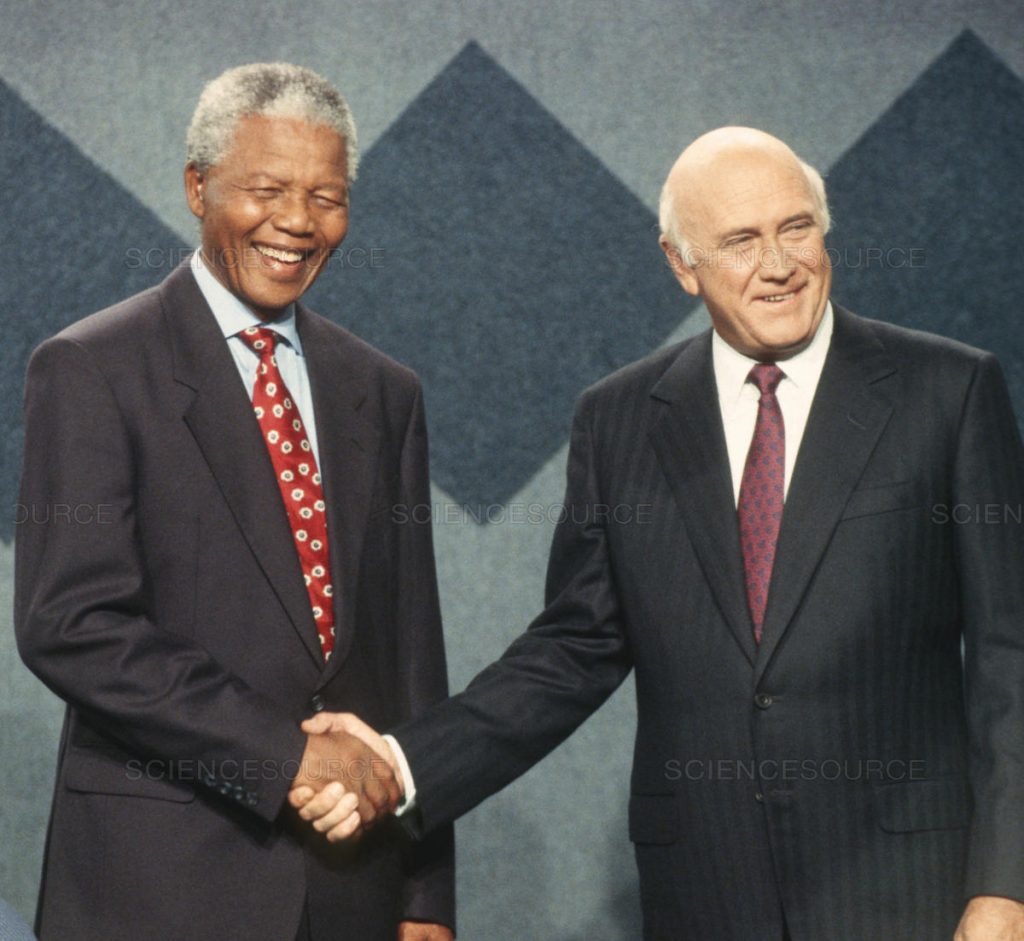
Nelson Mandela and de Klerk / sciencesource.com
13. Nobel Prize for Peace
Mandela and de Klerk were jointly awarded the Nobel Prize for Peace in 1993 for their efforts.
14. The first black president of South Africa
Between 1994-1999, Mandela was the first black president and the first democratically elected president of the ethnically united South Africa. As president, he introduced housing, education, and economic development initiatives designed to improve the living standards of the country’s black population. In 1995 he established the Truth and Reconciliation Commission (TRC), which investigated human rights violations under apartheid.
15. An advocate of peace, reconciliation and social justice
Mandela did not seek a second term as South African president and was succeeded by Mbeki in 1999. He retired from active politics but maintained a strong international presence as an advocate of peace, reconciliation, and social justice.
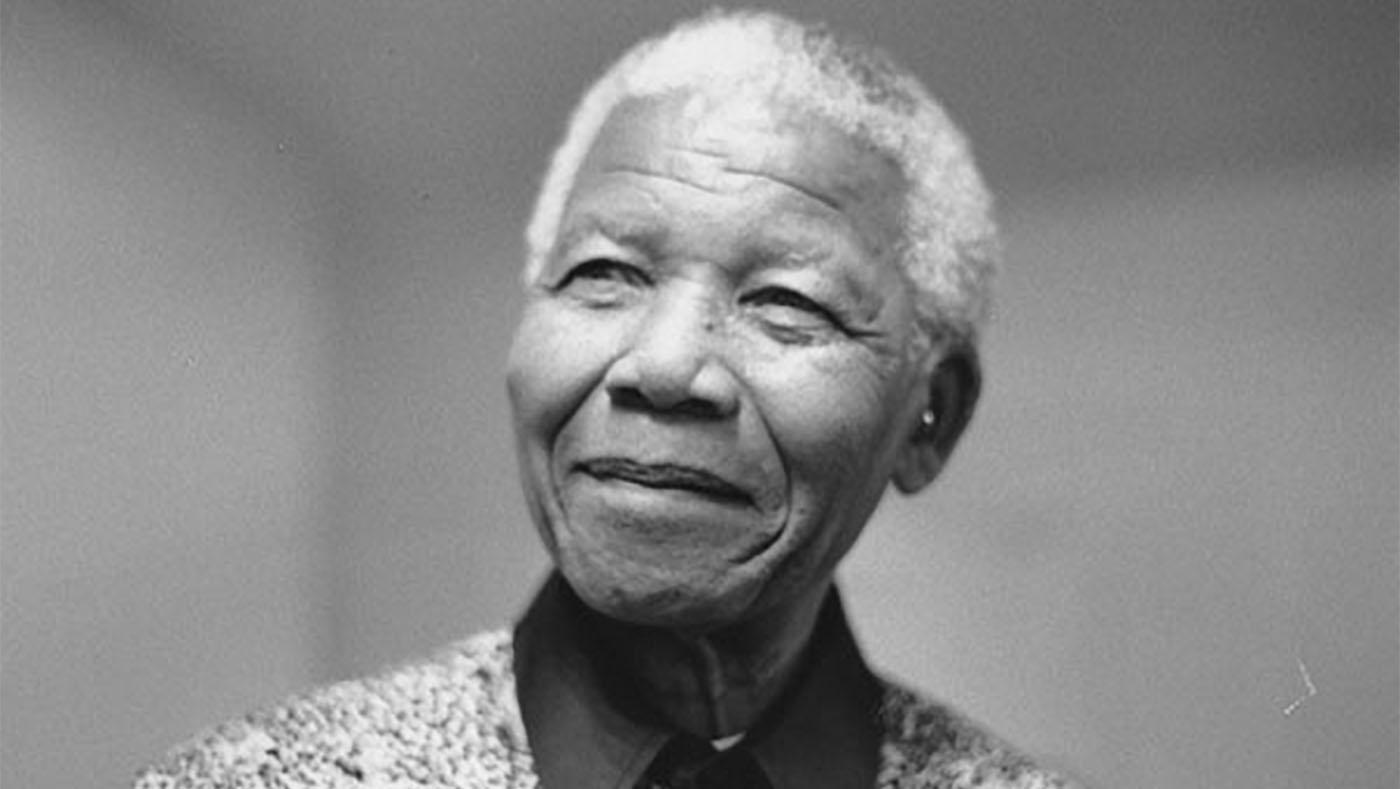
interactive.wttw.com
16. The Nelson Mandela Foundation
In 1999 he established the Nelson Mandela Foundation which focuses on contributing to the making of just societies. The foundation’s mission is to find sustainable solutions to the problems confronting humanity through deep dialogue informed by robust research, analysis and evaluation.
17. The Elders
In 2007 he was a founding member of the Elders, a group of international leaders for the promotion of conflict resolution and problem-solving throughout the world. Among the members of Elders, there are renowned leaders like the first woman president of Ireland Mary Robinson, the former UN secretary-general Ban Ki-moon, the former President of the USA Jimmy Carter and Archbishop Desmond Tutu.
18. Mandela Day
Mandela Day is celebrated every year on July 18, Mandela’s birthday. It was created to honour his legacy by promoting community service around the world. In 2009 the United Nations declared that the day would be observed annually as Nelson Mandela International Day.
19. Writings, speeches and autobiography
Mandela’s writings and speeches were collected in four books:
- ‘I Am Prepared to Die’ (1964; rev. ed. 1986),
- ‘No Easy Walk to Freedom’ (1965; updated ed. 2002),
- ‘The Struggle Is My Life’ (1978; rev. ed. 1990),
- In His Own Words (2003).
His autobiography Long Walk to Freedom was published in 1994.

Nelson Mandela / abcnews.go.com
sources: The Nelson Mandela Foundation, Encyclopaedia Britannica
Join the Conversation
We’d love to hear what you have to say.
Get in touch with us on Facebook Group and Twitter.
20+ Valuable Marketing Quotes and Insights From Experts (1 of 2)
Curious to learn what the latest valuable marketing quotes and insights are?
Marketing never stops spinning and marketers never stop learning. To help you update your knowledge and show you new directions, I put together a list of 20+ marketing quotes and insights from 20 marketing experts.
This article includes insights and quotes from Ann Handley, Jay Baer, Chris Brogan, Rand Fishkin, Tara Hunt, Seth Godin, Mark Schaefer, Martin Lindstrom, Mari Smith and Gary Vaynerchuk.
20+ Valuable Marketing Quotes and Insights From Experts
1. Ann Handley – Go Smaller & Slay the Ignosaurus
We’ve all heard of the Go big or go home saying. Writer, speaker and digital marketing pioneer Ann Handley makes a 180 turn and goes in the opposite direction. She invites marketers to thing bigger, but go smaller. Why?
Small stories are specific. Small stories are human-scale.
Ann Handley
Making the story smaller and more specific is the best way for products, services or B2B solutions to break through the noise of social media and get listened to by their customers.
Big and bold stories are often best told in small and specific ways. Find the specific details—and use them to engage the heart, not just appeal to the head.
Ann Handley
But in order to be able to tell these stories, we need to slay the Ignosaurus, the beast that we thought had disappeared together with the other dinosaurs.
Ignosaurus is lazy, bored, and goes through the motions with no engagement on the job.
Ann says a vast majority of marketers today are Ignosaurus in disguise.
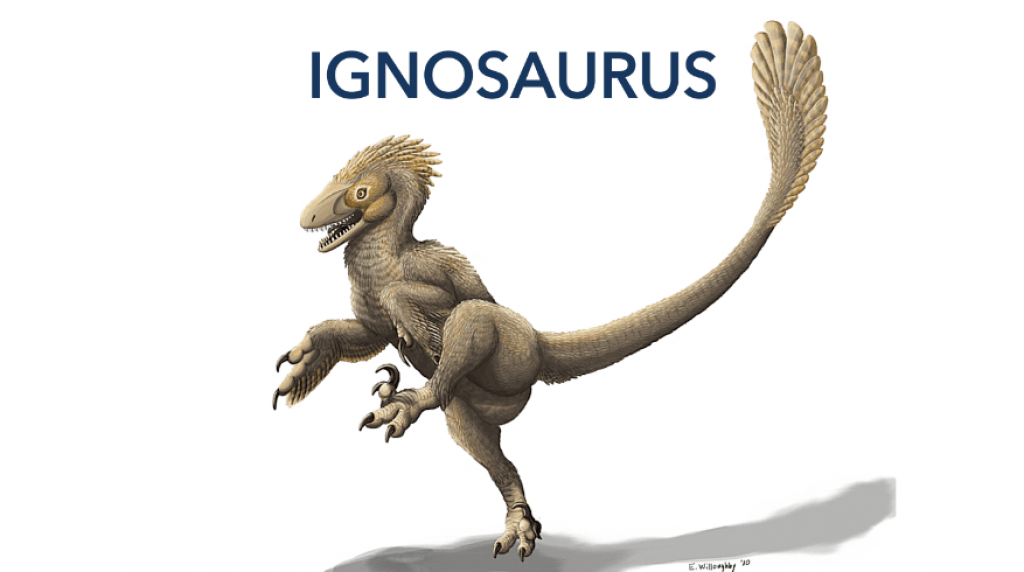
annhandley.com
She wants marketers to slay the Ignosaurus within and start experimenting, making changes.
In order for the industry to evolve marketers need to be curious and stay alert.
Study after study has shown that Marketing has one of the most pronounced skills gap of any industry. Many of us feel that we don’t have the skills we need to produce our best work.
Ann Handley
2. Jay Baer – Relevancy is a Value Exchange
Is your marketing failing?
Author, speaker and founder of Convince & Convert Consulting Jay Baer believes the reason your marketing is failing is the lack of relevancy.
Customers and prospects are trading their attention for your information. If they refuse to do so, it’s because your information does not matter to them enough sufficiently for them to trade attention for that information.
The key to being more relevant isn’t hard-it just takes time. The key to being more relevant is to understand your customers better.
The truth is that most modern marketers don’t actually interact with customers very much anymore, and that robs us of a really important success ingredient: insights.
Jay Baer
How do you get insights?
Not from reading spreadsheets or reports.
Jay says most marketers today have never seen their customers which is really sad.
How can you design marketing strategies and campaigns if you don’t know who are you talking to?
You need to change that today.

Leave the office and make contact. Spend time with your customer service and your sales team to learn what your customers’ problems are, what questions they ask, how they talk etc.
Almost no great marketing happens behind your desk. Great marketing occurs when you actually take the time to spend time with your customers and learn what they really need and what they’re really all about.
Jay Baer
3. Chris Brogan – Invite People to Your Picnic
I think even the biggest companies have to get a bit more “picnic-sized” in their looking at outreach, attraction, sales, and conversion. If you speak to everyone, you’re heard by no one. Sure, make your big ads say whatever they’re saying, but use your other resources to reach and engage with specific groups at a time.
Chris Brogan
How can a company reach people and serve those who would benefit from their services and products?
Speaker, author and marketing expert Chris Brogan says marketers need to make their customers feel seen and understood. Only then will they be ready to buy.
How do you make your customers feel seen and understood?

You need to split your customers into several communities of personas. Make groups for every community of people you think you can best serve. And then invite them to a picnic, online or offline and make them feel they belong. That’s how revenue is generated – by earning the attention and trust of all those people out there who feel invisible.
4. Rand Fishkin – The True Marketing Trends for 2019
Former founder of Moz and current founder of SparkToro Rand Fishkin believes marketing trends like video content, turning to the human side of marketing and data-driven creativity are completely non-actionable and can hardly be called trends for 2019.
Instead, he made a list of the trends he believes will have an impact on marketing in 2019.

Here they are:
- In the next few years, the US and other parts of the world will experience an economic recession which is already changing customers’ behaviour;
- The undue influence of big businesses and monopolies which resulted in bad news for citizens: GDPR, the loss of Net Neutrality, Articles 11 and 13;
- A recent analysis showed a dramatic slowdown in the global growth of internet access. To keep making the same revenue as in past years, most internet giants compete with publishers, limit organic reach, cannibalize clicks and make channels pay-to-play;
- Voice Answers have the potential to disrupt any competitive opportunity to appear in results and earn traffic and value;
- The emerging, broad societal belief that overuse of social networks and heavy web content consumption do more harm than good. Many people today are limiting their screen time and their children’s.
What steps is your company taking to adapt to the future?
5. Mark Schaefer – The Belonging Crisis
Author, speaker and marketing expert Mark Schaefer says
Most of our marketing is occurring without us because today the customers are the marketing department. The new challenge for a company is to be invited to those organic conversations.
We live in an era when hyper-empowered consumers control the brand narrative.
In the past, a “brand” is what we told our consumers. Today, a brand is what our customers are telling each other.
Mark believes there is a belonging crisis today in the world.

Here is what marketers should do to help companies overcome this trend according to Mark:
- Align with the values of your young customers, empowering their voices, and creating deep emotional attachments with customers that result in loyalty;
- Help your customers feel connected;
- Provide personal attention to your customers. “It’s not “personalized” — it’s personal!”
- Nurture like-minded customer “islands” on Facebook and other spaces;
- Use true personal connections instead of automated messages and spammy responses;
- Traditional ads that lead to “awareness, trial and loyalty” don’t work so well any more. Build a brand from a place of empathy and personal pain;
- Assemble a tribe, united in their belief in how the product or service connects them to their individual lives and to their communities.
6. Mari Smith – Use Stickers in your Facebook Video Ads
Often referred to as the Queen of Facebook, Mari Smith provides marketers with many valuable and useful insights on Facebook and Instagram marketing.
Stickers on videos can significantly improve the performance of your Facebook ads.
Mari Smith
Mari and her team performed a test to see how stickers influence the results of Facebook video ads.
Here’s what she found:
- Cost per result for ads with stickers was almost 33% lower;
- Both Conversion rate and CTR were higher;
- Stickers don’t impact interest in the ad copy so much as generate interest in the advertised product;
- If you are looking to use stickers in your Facebook video ads pay attention to the number of stickers you add, don’t overdo it!

7. Gary Vaynerchuk – The $1.80 Instagram Strategy
Gary Vaynerchuk spent the last 10 years of his career trying to understand user psychology and reverse engineer attention into an engaged community online.
The truth is, the way to win on social media is to actually be social. The number of Instagram followers you have means nothing if you can’t build a community of like-minded people who care and engage. The only real way to do this from scratch is to become part of the conversation.
Gary Vaynerchuk
That’s how he came up with the $1.80 Instagram strategy.

garyvaynerchuk.com
What is the $1.80 Instagram strategy?
It’s leaving your personal .02 cents on the top 9 trending Instagram posts for 10 different hashtags that are relevant to your brand or business every single day.
All you need to do is provide value where you can and it only takes 2 minutes a day. He says it’s exactly the strategy that always worked for him – becoming part of the community. The result is you will have meaningful connections, not bots. And this kind of connections is the most valuable.
8. Tara Hunt – No, that’s not marketing
Executive-level digital marketing professional Tara Hunt makes it clear on what marketing is not.
Contrary to popular believe, advertising isn’t the same as marketing. PR is not the same as marketing. Communications isn’t the same as marketing and Branding isn’t the same as marketing either. Even Sales is often completely separate from marketing. Brand and advertising and PR and content and digital and consumer insights and pricing and social and events and product and positioning and communications and a whole bunch of other stuff are all part of the marketing toolkit, but they aren’t “marketing.”
Tara Hunt
Videos, podcasts and content, in general, are great tactics for the right audience but they’re not marketing. They won’t automatically open the floodgates of customers.
Here’s what marketers should do according to Tara:
- Understand their market;
- Understand if they have the right product for that market (if not, let their client know they are focusing on the wrong market or need to change the product);
- Identify the right channels of distribution for both product and message;
- Put it all together in a measurable plan.
Anything less is not marketing.
9. Seth Godin – 10 words per page
Seth Godin is the only person to have been inducted in the Direct Marketing Hall of Fame and the Marketing Hall of Fame. His blog is one of the most successful blogs in the world with 7000 published articles and millions of readers.
We are also proud that Seth Godin was one of the keynote speakers at BRAND MINDS 2017.
Here are 4 insightful quotes:
Any metric you can buy your way out of is probably not a useful metric to measure yourself by.
![]()
Every interaction you have with a customer either strengthens your relationship (because it’s mutually beneficial) or weakens it. Weaken it enough time and you break it.
Ten words per page
That’s how many words get scanned the first time through. Perhaps five on a billboard.
Which means that your memo, your ad, your announcement, your post–you get ten words.
If you can begin with the ten words and write around them, you have the foundation for an effective message.
When in doubt, when your marketing isn’t working, the answer is easy: go one circle in.
seths.blog
10. Martin Lindstrom – Build Anticipation
Neuromarketing and branding expert Martin Lindstrom draws attention to the concept of anticipation.
Anticipation is the feeling of excitement about something that is going to happen in the near future. It is a powerful feeling and it is directly linked to connectedness and engagement over a longer period of time.

In our world of on-the-spot gratification, how are brands leveraging anticipation to keep their customers close and engaged? Technology has taken anticipation away.
From a rational point of view, anticipation is nothing more than an illusion, a myth, a chimaera; but from a subconscious, storytelling, and emotional point-of-view, anticipation makes all the difference. It is the bride’s months-long excitement as she chooses her gown, the anxious lead-up to graduation day, the indescribable feeling as the newborn baby finally arrives home and settles into its beautifully decorated bedroom.
Martin Lindstrom
If your brand offers experience, anticipation plays an important role in your customers’ perception of it. Anticipation has the power to make the wait much more rewarding and it makes all the difference. It sets your brand apart from your competitors and influences the bottom line.
Stay tuned for part 2!
Join the Conversation
We’d love to hear what you have to say.
Get in touch with us on Facebook Group and Twitter.
Agricool – Reinventing the Way Strawberries are Grown
Do you care what goes into your food? Would you still eat it should you know it was sprayed with harmful substances?
Agricool has reinvented the way strawberries are grown.

Agricool is a startup founded by Gonzague and Guillaume, two sons of farmers.
Their childhoods were full of excellent fruits and vegetables, but when they moved to the city, they didn’t want to lose the ability to eat great food. That’s why they invented a system that allows them to grow tasty fruits and vegetables locally and without pesticides, at a price that everyone can afford.

Guillaume and Gonzague in one of their cooltainers / agriculture.gov.fr
Agricool – The Story
They started growing their own strawberries in an apartment in 2015. The strawberries were tasty but the apartment was not an appropriate place for a committed enterprise. They found an old container sitting in the courtyard of Gonzague’s parents’ farm and a great idea was born. The container was a perfect solution for growing their strawberries: it was recyclable, transportable, and able to be placed anywhere. That’s when Agricool took off! A year later Guillaume and Gonzague moved into a proper factory, a new office and hired engineers and agronomists to help them achieve their dream.
One team, one mission, Our mission is ambitious.
To complete it, we need the best, those who are able to reinvent agronomy and engineering as we know it. Those who can challenge the status quo, reinventing the system of food production. We received more than 700 applications and went from two founders to a team of 30 in just one year.

photo: Agricool Facebook Page
Agricool – Reinventing Agriculture with Cooltainers
Agricool has found an innovative way to grow fruits and vegetables which doesn’t harm the environment and is cost effective – the cooltainer.
Here is more on the solution Guillaume and Gonzague have come up with to bring tasty strawberries to Parisiens:
- They grow strawberries in shipping containers called cooltainers; instead of growing on the horizontal, their strawberries grow vertically;
- This allows them to use very little surface area to produce fruits and vegetables – 120 times less than in a field;
- They put their engineering skills to the test and successfully managed to obtain the perfect growing conditions inside the cooltainers in order to produce tasty strawberries;
- Their plants are fed with synthetically-produced nutrients in a closed circuit system which ensures efficiency and sustainability;
- LEDs create the ideal spectrum of light for the plant’s development;
- They consume only renewable energy;
- Their business model created the urban farmer, called the Cooltivator; they encourage and support people to become Cooltivators and grow their own vegetables and fruits;
- The cooltainers are 100% connected; they can analyze all data in real time.
No one wants to eat pesticides anymore. No one wants to harm the planet with the pollution that comes from transporting food. Everyone wants to find real flavour again, the flavour that our grandparents had with their fruits and vegetables. And there’s only one way to do that: to stop wishing and start making it happen.
Guillaume Fourdinier (source)

photo: Agricool Facebook Page
Agricool – Benefits
- Agricool produces in 30 sq. meters the equivalent of what traditional agriculture produces in 4000 sq. meters of fields;
- Agricool strawberries are 100% GMO-free and pesticide-free;
- They use 90% less water than traditional farming and no nutrients are lost to the soil;
- 100% locally produced;
- Because their strawberries are grown in the middle of Paris, Agricool eliminated the need for transportation which makes the business cost efficient;
- Thanks to this solution, they can supply customers with fresh and tasty strawberries all year round.
Agricool – The Future is Bright
Agricool has raised a total of $41.4M (crunchbase.com) to date and is planning to expand to other fruits and vegetables. According to TechCrunch, Agricool plans to launch 100 containers by 2021 in Paris and Dubai and hire around 200 people to help them achieve their mission.
Join the Conversation
We’d love to hear what you have to say.
Get in touch with us on Facebook Group and Twitter.
Vacation Time: 17 Tips & Rules for Employees, CEOs and Organizations
It’s summertime and people are thinking about going on vacation. Soaking up the sun on the beach or hiking up the mountains? Whichever you prefer, all employees must take vacation time off.
What this article talks about:
- 6 rules for good managers to encourage employees to take their vacation time;
- 8 tips for employees looking to have a relaxing and guilt-free vacation;
- 1 rule for CEOs to follow in order to have a relaxing vacation;
- 2 vacation policy recommendations for organizations (with examples).

Americans – the No Vacation Nation
A recent survey conducted by Kimble Applications dubs the Americans the No Vacation Nation. This survey concludes Americans are overworked, under pressure and not taking time off from work.
Here are the survey’s main findings on how many Americans take time off and why they struggle to leave the office and go on vacation:
- 53% don’t take their vacation days;
- 27% say they just have too many projects or deadlines to take time off;
- 13% fear they’ll return to too much work;
- 19% are anxious about being away from work;
- When they do go on vacation 48% say they proactively check in on work;
- 14% believe that employees are more likely to succeed and advance in their career if they choose not to take all
- of their vacation time;
- 19 % say that they’ve felt pressured by their employer or manager to not take their vacation time off.
What are the consequences of this situation?
Accumulated stress, increased fatigue, depression, decreased productivity rates and ultimately burn out.
On May 25, theWorld Health Organization (WHO) formally defined the syndrome as energy depletion, exhaustion and negativity resulting from chronic workplace stress (source).
Working while on vacation is also bad for your health. It ruins your relationship with your spouse and your kids.
How would you feel if your children believed you loved your work more than you loved them?

6 Rules for Good Managers
You are certainly familiar with the saying People don’t leave companies, they leave bad managers.
Vacation time is vital for the employees’ physical and mental health as well as for work productivity and good managers should encourage them to take it.
Good managers:
- Don’t frown upon employees taking up vacation;
- Don’t make their employees feel shame or guilt around vacation;
- Are the first to set a good example and take their allotted vacation days;
- Never call or email their team members while on vacation;
- Assure him/her the team can handle anything that could come up while they are away;
- Expect their team members to disconnect, relax and focus on making amazing memories and get back to work feeling recharged.
I was inspired to write this article after reading a LinkedIn post by Brian Dresher, one of my 3rd-degree connections. At the time I had made a mental note to come back to Brian’s post and refer to it in my article. Unfortunately, I had failed to save the link to his post. I hadn’t liked his post either so it didn’t show in my LinkedIn activity. I searched for Brian’s post for three hours and I was beginning to come to terms with the fact that I wasn’t going to mention it in my article when I suddenly found it! Hooray! What a relief!
You can see why I was so adamant to show it to you:
8 Tips for Employees looking to have a relaxing and guilt-free vacation
Going on vacation is mandatory if you want to avoid a drop in productivity, increased levels of stress and fatigue.
But if you want to have a great time during your vacation you need peace of mind.

Here are 8 tips for employees looking to have a relaxing and guilt-free vacation:
- Communicate the time you will be out of the office to your prospects/customers;
- Don’t call your prospects/customers while on vacation!;
- Make sure you get done the important tasks in your final working week so you can enjoy your time at the pool sipping cocktails;
- Handover important tasks to your colleagues so you can relax knowing they’re being taken care of while you’re away;
- Stay off your smartphone, limit yourself to checking it only an hour a day;
- Make a rule of not checking your office emails and stick to it;
- Anticipate any needs your colleagues might have and prepare a word document or spreadsheet to answer them;
- Appoint one of your colleagues to handle your customers’ needs while you’re away.

2 Vacation Policy Recommendations for Organizations
Netflix, which disrupted the TV entertainment industry and made binge-watching a cultural phenomenon has a strong company culture. An important aspect of this culture is its unlimited vacation policy. This policy states that employees are free to intermix work and personal time at their own will and take time to go on vacation.
Netflix CEO Reed Hastings sets a good example in this respect – he takes 6 weeks’ vacation. Why? Because “it helps you get back to work with fresh new ideas.”
Learn more: 8 Key Factors Behind Netflix’s Success Story
Like almost all tech startups in Silicon Valley, Buffer had an unlimited vacation policy for its employees as a company perk just like Netflix. What management at Buffer didn’t expect was employees barely taking any vacation at all.
They realized the main problem with unlimited vacation time was not knowing how many days off someone should take which prompted the company to go through a series of policy adjustments. The company went from unlimited vacation to offering its employees a $1000 bonus to go on vacation, a minimum vacation policy of 15 days off to a full-team Buffer is closed strategy.
For the first time, we’re closing Buffer for a mid-year holiday (Wed-Fri). Here’s a lil’ thread on holidays and time off on our distributed team. Maybe it’ll help others in #remotework!
— Courtney Seiter (@courtneyseiter) July 2, 2019
Here are 2 recommendations regarding your organization’s vacation policy:
1. Have a vacation policy in writing
To have everyone on the same page, write down your vacation policy and communicate it across your company. The goal of having a written vacation policy is to lay down ground rules and be prepared to answer questions from your employees.
2. Avoid schedule conflicts
If you cannot have your company close for a limited amount of time – like Buffer – is not a solution, then stick to your employees scheduling their vacations which – more often than not – leads to schedule conflicts.
To avoid such unpleasant situations, you need a set of rules. You can go with first come, first approved rule or 3 employees at all times rule and provide them with an editable calendar so they can self-manage their vacation days to follow this rule.

1 rule for CEOs having a relaxing vacation – Empowered Employees
You are the CEO of your company. You worked hard to take your company off the ground and in the first years since launching your business, you took no vacation at all.
Now the company is powered by your employees and business operations run smoothly. It’s time for you to take the much-needed time off and go on vacation.
Having a great summer vacation is conditioned by one thing only: that you have been actively empowering your employees throughout the year.
Why?
Because empowered employees don’t need micromanaging, they are responsible and can be trusted to make the right decisions for the company. Empowered employees have stronger job performance and are more driven to take care of the needs of the customers they serve. When you empower your employees, they ensure the success of your business.
What steps does your organization take to encourage its employees to go on vacation?
What is the vacation policy of your company?
Share your thoughts in the comments.
Join the Conversation
We’d love to hear what you have to say.
Get in touch with us on Facebook Group and Twitter.
Tara Westover LIVE at BRAND MINDS 2020
Tara Westover is one of today’s Best Selling Authors and a keynote speaker at BRAND MINDS 2020.
Read on to learn more about Tara Westover.
‘Educated: A Memoir’ – No 1 on the New York Times Best Sellers List 2019
At the time I am writing this article, Tara’s memoir ‘Educated’ has been No 1 on the New York Times Best Sellers for the past 70 weeks.
The book was published in 2018 and it has been earning various accolades ever since. It was named one of the Best Books of the Year by The Washington Post, Oprah Magazine, Time, NPR, Good Morning America, The San Francisco Chronicle, The Guardian, The Economist, The Financial Times, The New York Post etc.
‘Educated’ describes Tara’s upbringing in her separatist family with radical views of the world and how these values influenced her life and the lives of her siblings.
Tara’s memoir is currently being translated into more than 30 languages.
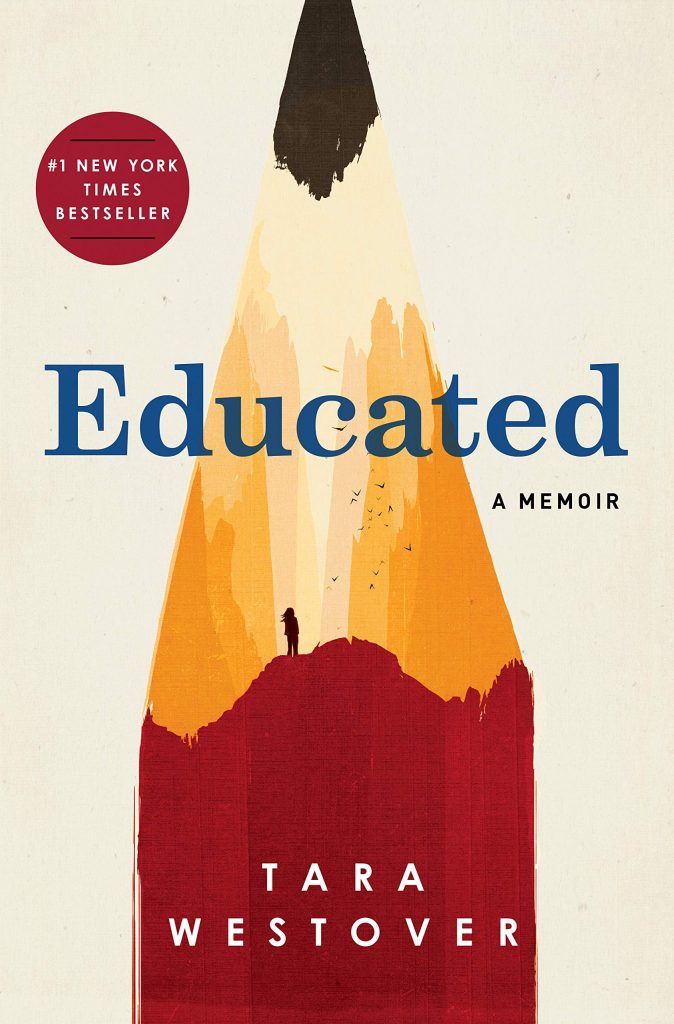
amazon.com
‘Educated’ Awards and Recognition
Educated earned a slew of awards among which:
- Book of the Year by the American Booksellers Association;
- One of the New York Times’s 10 Best Books of 2018;
- Winner of the Goodreads Choice Award for Autobiography;
- Amazon Editors’ pick for the Best Book of 2018;
- Apple’s Best Memoir of the Year;
- Audible’s Best Memoir of the Year;
- Long-listed for the 2019 Andrew Carnegie Medal for Excellence.

Bill Gates and Tara Westover / tarawestover.com
Tara’s process of self-discovery is beautifully captured in Educated. It’s the kind of book that I think everyone will enjoy, no matter what genre you usually pick up. She’s a talented writer, and I suspect this book isn’t the last we’ll hear from her. I can’t wait to see what she does next.
Bill Gates
Her amazing life story of overcoming a difficult childhood
Now in her 30s, Tara Westover is the youngest of seven children. She lived on a mountain in rural Idaho with her siblings and survivalist Mormon parents. What does survivalist mean? It means her parents didn’t believe in many things we take for granted like doctors and hospitals, the government, public education etc.
Tara had a very difficult childhood which she describes in harrowing stories: she suffered many physical injuries – from a spike going through her leg to a car crash when she was 14 – as well as emotional and physical abuse from one of her brothers. Her parents didn’t provide the comfort, warmth and understanding that she needed so she gradually became estranged from them.

Tara Westover and Oprah / oprah.com
No birth certificate but a PhD from Cambridge University
Tara didn’t have a birth certificate due to her parents’ extremism and didn’t attend primary school but when she got older she decided she wanted to go to college. Her parents didn’t support her because she was going against their family values.
To get into college she pretty much taught herself algebra, mathematics, grammar, and science. She was such a great learner that she was admitted to Brigham Young University.
She had a rough four years at the university but not because she was a bad student, it was because she didn’t know much about the world like everyone else. For example, she had never heard of the Holocaust or the civil rights movement, Napoleon or Martin Luther King or simple facts like Europe is not a country, but a continent.
I think education is really just a process of self-discovery, of developing a sense of yourself and what you think.
Tara Westover
She graduated Magna cum Laude and subsequently won a Gates Cambridge Scholarship. In 2010 she was a visiting fellow at Harvard University and in 2014 she received a PhD in history from Cambridge University.
It’s an engrossing read, a fresh perspective on the power of education, and it’s also a testament to the way grit and resilience can shape our lives.{…} Tara’s upbringing was so different from my own, but learning about her world gave me insight into lives and experiences that weren’t a part of my own journey. To me, it’s an example of the extraordinary power of storytelling.
Michelle Obama, in the New York Times
100 Most Influential People in 2019 by Time Magazine
Time Magazine included Tara Westover in their list of 100 Most Influential People of 2019 which features artists, activists, politicians and entrepreneurs, chosen for their exciting and impactful ideas.
Join BRAND MINDS 2020 – The Growth Weekend on September 25th and watch Tara Westover speak about The Power of Education!
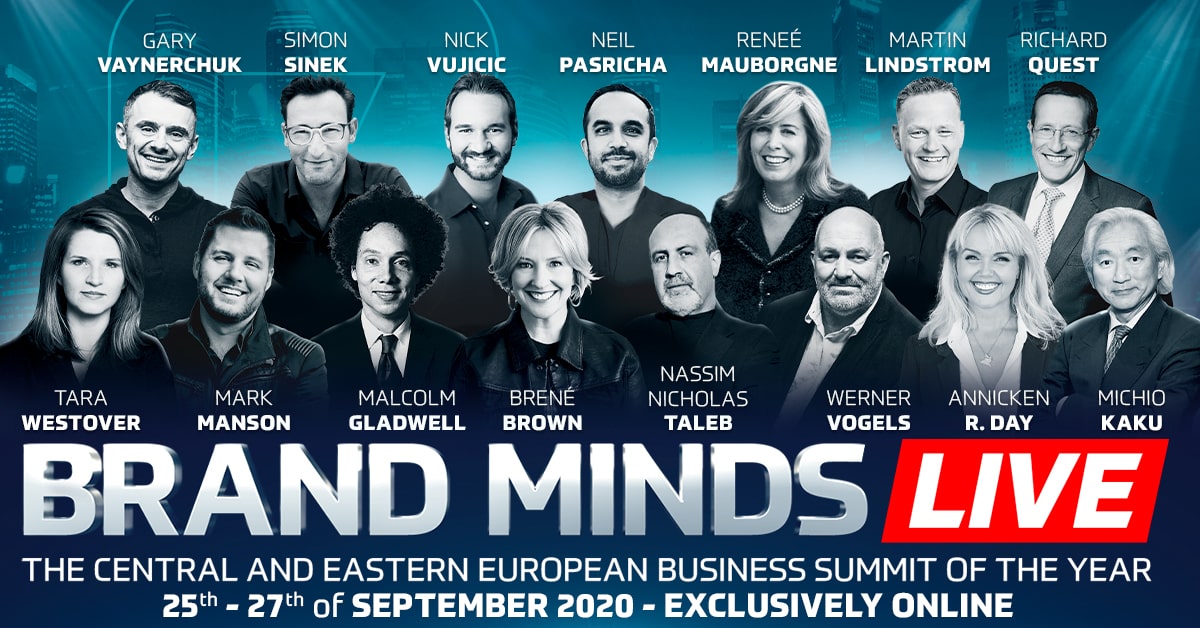
Certified B Corporations – Using Business as a Force for Good
Certified B Corporations are a new type of businesses – they are using business as a force for good.
If you are looking for a way to prepare your business for the future, this article is for you.
Our failures are a painful but necessary teacher
The business landscape has a major influence on our world today. It is no longer acceptable to make money at any cost because it inevitably leads to an economic downturn. The latest example is the financial crisis which began in the USA in 2007 and lasted until 2009. We know now that selfish and greedy capitalism caused this recession with consequences felt worldwide. The housing industry collapsed, many Americans lost their homes and their jobs, over 230,000 U.S. businesses closed, the construction and manufacturing industries experienced double-digit losses in employment and European economies overall contracted.
The present is changing
The business environment encouraged and awarded a dog-eat-dog mentality among employees where there were no teams, but individuals competing with each other; where everyone had their own agenda and used all means necessary to come on top; where companies and corporations were looking to maximize profits by any means; where the interests of their shareholders came before the interests of their customers; where employees were easily replaced and rules were often bent at the expense of ethics and integrity.
What is the impact of your business?
Those days are long gone and fortunately, the business environment has learned its lesson.
We are living in the age of digital connectivity, transparency and instant access to news from all corners of the world.
Corporations and big companies no longer control the conversations around their products or their brand – their customers do.
We’re in the middle of a revolution and the customers are leading the charge. They are looking at the way businesses influence our world – for better or for worse. Is your business bad for the environment? Is your company producing plastic waste which has become a global problem? Are you helping communities to grow and have a better life? How do you treat your workers?
Certified B Corporations – using business as a force for good
In 2006, three friends – Jay Coen Gilbert, Bart Houlahan and Andrew Kassoy – left careers in business and private equity and created an organization dedicated to making it easier for mission-driven companies to protect and improve their positive impact over time – the Certified B Corporation.
Certified B Corporations are businesses that meet the highest standards of verified social and environmental performance, public transparency, and legal accountability to balance profit and purpose.
B Corps are accelerating a global culture shift to redefine success in business and build a more inclusive and sustainable economy.
Here are the main goals of B Corporations:
- Reduce inequality;
- Lower the levels of poverty;
- Create a healthier environment;
- Build stronger communities;
- Create more high-quality jobs with dignity and purpose.
B Corporations use profits and growth as a means to a greater end: positive impact for their employees, communities, and the environment.
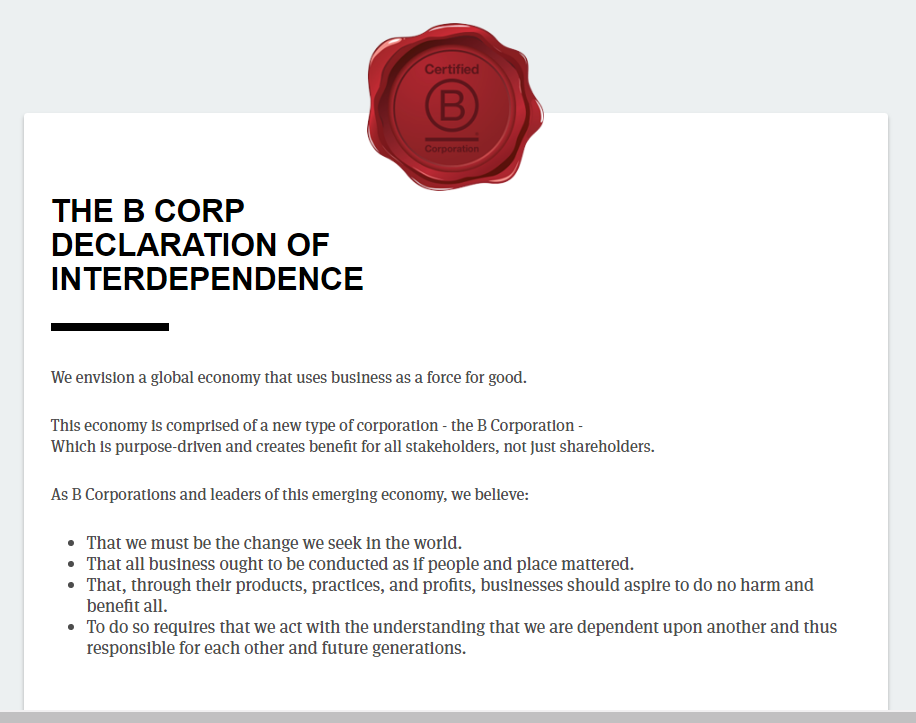
bcorporation.net
A business receives the B Corp Certification if it achieves a minimum verified score on the B Impact Assessment—a rigorous assessment of a company’s impact on its workers, customers, community, and the environment—and make their B Impact Report transparent on bcorporation.net.
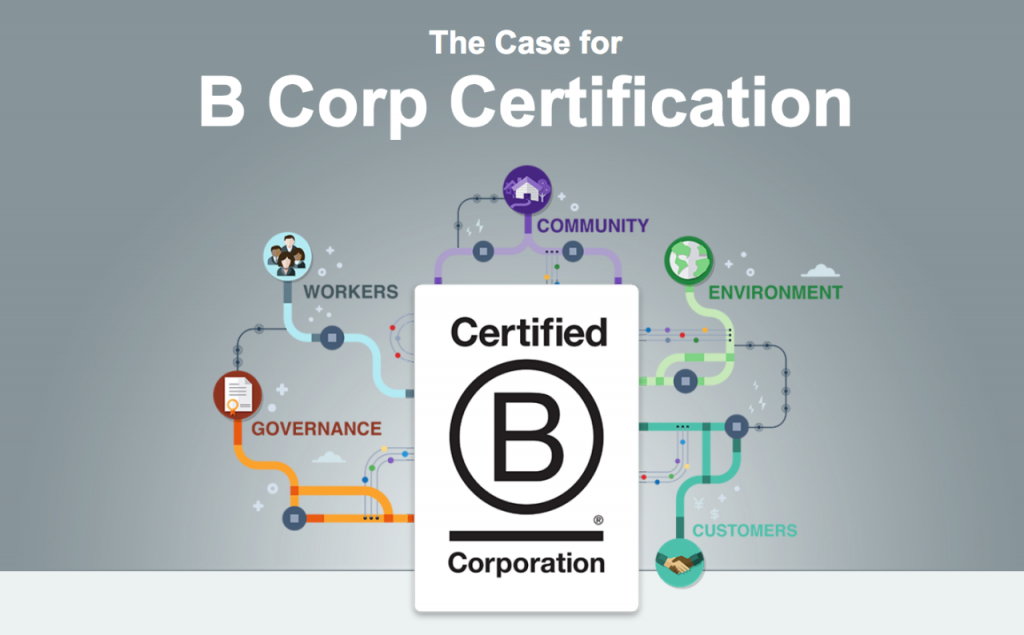
B Corp Facebook Page
Certified B Corporations also amend their legal governing documents to require their board of directors to balance profit and purpose.
There are currently 2788 B Corporations in 150 industries and 64 countries.
Here is how B Corporations stand out from other companies:
- They are 81% more likely to have transgender-inclusive healthcare coverage;
- The vast majority of B Corp employees are highly satisfied with where they work;
- B Corps are nearly 2x as likely for the majority of their managers to come from underemployed groups;
- They outperform other businesses by 16% on addressing climate change;
- 88% of service-industry B Corps allow flex-time schedules;
- They are 87% more likely to manage greenhouse gas emissions reduction;
- B Corps are 27% more likely to pay all of their hourly workers a living wage.
I first learned about the Certified B Corporation while researching Ecoalf, the first fashion brand in Spain to become a B Corporation. Sustainability is an important topic on BRAND MINDS blog and I addressed it by covering European companies which hold sustainability as one of their core values (you can find them in the Success Stories Series).
The second company I found was Certified B came as a surprise: Once Upon A Farm whose Chief Brand Officer is Hollywood actress Jennifer Garner. You can read about the company here: 3 Successful Businesses Founded by Hollywood Stars.
Here are other prominent B Corps and their overall B Impact score (which can range between 0 and 200):
- Patagonia Works, the leading outdoor apparel company which takes responsibility for their entire supply chain, pushing for just working conditions while protecting the environment (151); learn more about Patagonia in my article When Authenticity is Your Brand’s ….Brand
- Danone UK, North America, Egypt, Iberia and Canada, the food and beverages manufacturer (80);
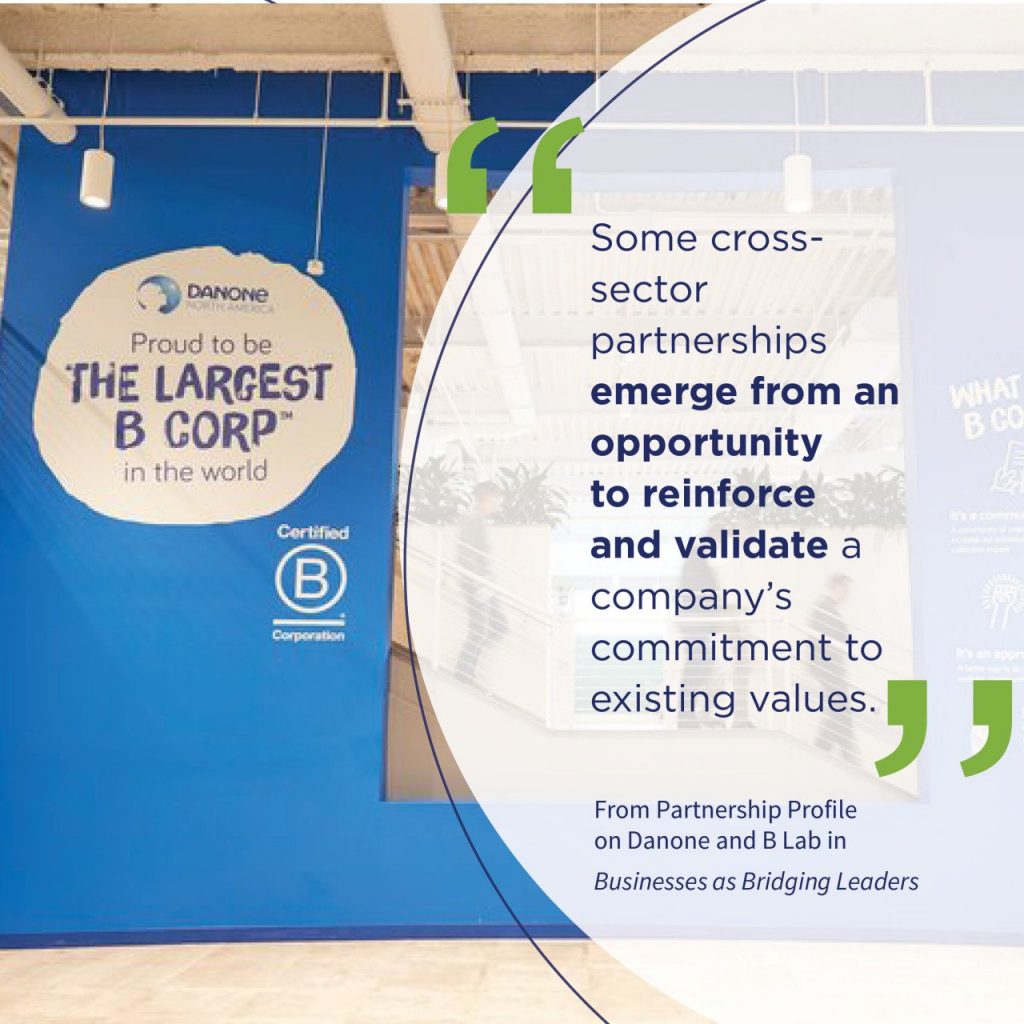
B Corp Facebook Page
- Hootsuite, the social media management platform (85); read Hootsuite: 5 Top Social Media Trends for 2019
- Natura, the Brazilian cosmetics company (120).
Do you want to measure your company’s impact on its workers, community, environment and customers?
Take the free B Impact Assessment!
Join the Conversation
We’d love to hear what you have to say.
Get in touch with us on Facebook Group and Twitter.
Waymo One – the world’s first fully self-driving taxi service
Have you ever wondered how many hours you spend in traffic as a driver?
Here are a few statistics regarding time spent in traffic jams across Europe and the US (source):
- Drivers in London spent an average of 74 hours waiting in traffic in 2017, Parisians 69 hours, while drivers in Geneva and Zurich lost 52 and 51 hours respectively;
- If patience is not your strongest suit, don’t take jobs in Los Angeles or Moscow because you will find yourself wasting 102 hours stuck in traffic and 91 hours respectively.
That’s a lot of time you could spend more productively like answering emails or reading a book than standing behind the wheel getting upset because you are travelling at the speed of a snail!
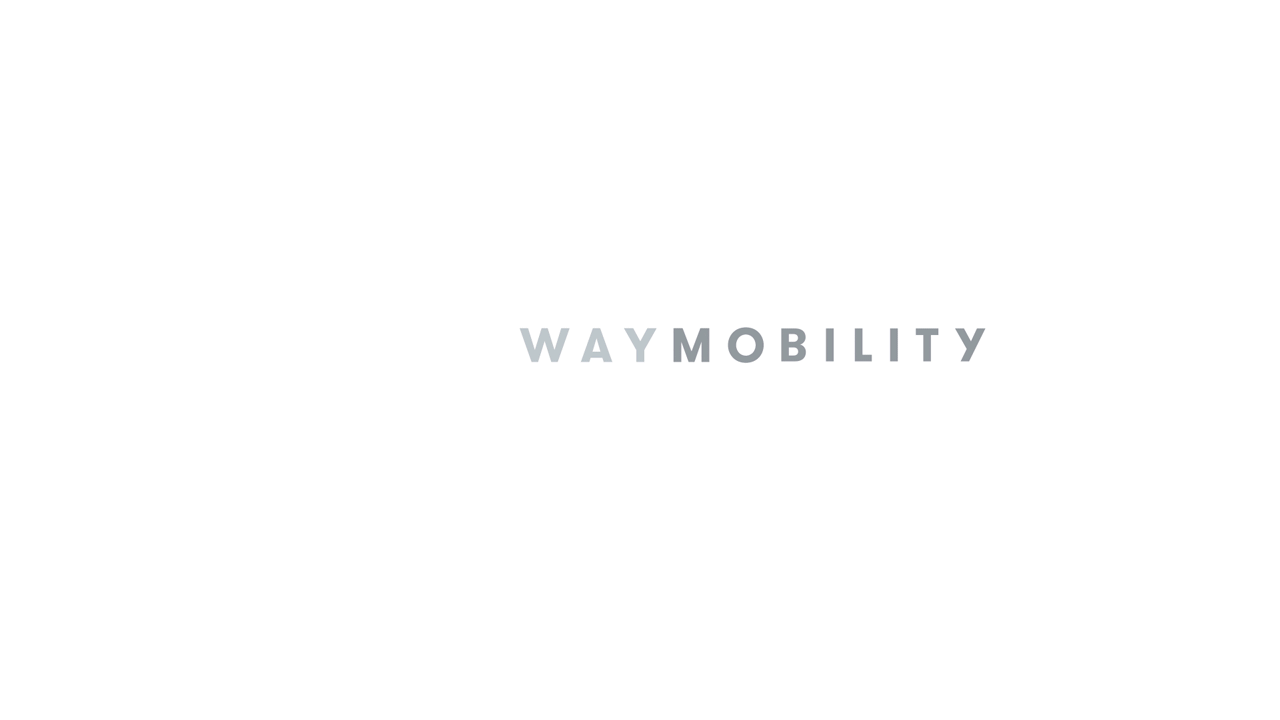
Waymo is a self-driving technology company with a mission to make it safe and easy for people and things to move around.
In 2018, the company launched Waymo One, the world’s first commercial fully self-driving taxi service.
Mission
Waymo’s mission is to make it safe and easy for people and things to move around. We aim to bring fully self-driving technology to the world that can improve mobility by giving people the freedom to get around, and save thousands of lives now lost to traffic crashes.
Waymo
Self-Driving Technology
Waymo leverages the latest developments in self-driving technology. The Waymo car is fitted with sensors and software that are designed to detect pedestrians, cyclists, vehicles, road work and more from up to three football fields away in all 360 degrees.
The car is provided with its own detailed map that highlights information such as road profiles, curbs and sidewalks, lane markers, crosswalks, traffic lights, stop signs, and other road features.
The car’s sensors scan constantly for objects around the vehicle—pedestrians, cyclists, vehicles, road work, obstructions—and continuously read traffic controls, from traffic light colour and railroad crossing gates to temporary stop signs.
The software predicts the movements of everything around the vehicle based on their speed and trajectory. It tells the difference between a cyclist, a pedestrian and a car and understands that each of them moves differently.
Based on all this information, the car’s software determines the exact trajectory, speed, lane, and steering manoeuvres needed to progress along its route safely.

The Waymo driverless car / waymo.com
Driverless cars – Benefits
There have been 1.25 million deaths worldwide due to vehicle crashes in 2014 and 94% of crashes involved human choice or error in the US.
Vehicle crashes are usually the result of speeding, alcohol, distraction, drowsiness.
Waymo eliminates these causes making the roads a lot safer for everyone.

Firefly / waymo.com
Waymo company history and statistics:
- 2009 – Waymo begins as a Google self-driving car project lead by Google employees working on AI and machine learning;
- 2015 – the project creates the Firefly, the first driverless car equipped with custom sensors, computers, steering and braking but no steering wheel or a pedal; the car passes the test by driving around a legally blind person;
- 2016 – the driverless car project spins off under Google and becomes Waymo;
- 2017 – Waymo begins testing its fully self-driving vehicles on public roads without anyone in the driver’s seat;
- 2018 – Waymo One is launched;
- Over 1000 customers since launch;
- 400 people successfully applied to be in the Waymo early rider programme;
- the company currently has 600 autonomous vehicles on the road;
- Waymo has ordered 62,000 more Chrysler Pacificas and 20,000 I-Pace self-driving cars from Jaguar;
- Waymo’s fully self-driving technology has driven over 10 million miles on real-world roads since 2009;
- 10 years of building the AI-based technology for driverless cars;
- $5M in estimated revenue annually according to CrunchBase;
- The company currently has 13 team members.
Latest news
In the first half of this year, Waymo announced a series of exciting news: the opening of its factory in Detroit and two partnerships – the first with Lyft (allowing Lyft users to select a Waymo car instead of a human-driver) and the second with Renault and Nissan on behalf of The Alliance (to explore driverless mobility services for passengers and deliveries in France and Japan).
What’s next for Waymo?
The future is bright for Waymo and it includes adding more driverless cars to its fleet, expanding beyond Phoenix and testing self-driving trucks.
Join the Conversation
We’d love to hear what you have to say.
Get in touch with us on Facebook Group and Twitter.
The Self-Improvement Industry Is Estimated to Grow to $13.2 billion by 2022
According to Market Research, the self-improvement market was worth $9.9 billion in 2016 and is estimated to grow to $13.2 billion by 2022 with 5.6% average yearly gains.
Self-improvement is about consciously identifying and developing one or more facets of your life. From the perspective of an entrepreneur, self-improvement will often entail some sort of mental training but can mean anything from practising stress management to valuable goal-setting. Professionals are often keen to learn things like time-management techniques (for better prioritising tasks) and increasing productivity without compromising mental wellbeing.
The self-improvement market is wide and encompasses a large variety of products and services which range from books to e-books, online courses, coaching programs, webinars, “academies”, “universities”, “masterminds”, masterclasses, conferences, mobile apps etc.

Join BRAND MINDS 2023.
![]() Learn more: The Health & Wellness Industry is now worth $4.2 trillion
Learn more: The Health & Wellness Industry is now worth $4.2 trillion
Here are various markets related to the self-improvement industry and how much they are worth according to Market Research:
- Self-help audiobooks – $769 million (5.6% growth YoY);
- Self-improvement books – $800 million (6% growth YoY);
- Self-improvement apps – $27 million;
- Personal coaching services – $1 billion in the US (source);
- Motivational speakers – $1 billion per year combined.
Self-improvement industry statistics
- Millennials are driving the growth of the self-improvement industry;
- 94% of millennials reported making personal improvement commitments and said they’d be willing to spend nearly $300 a month on self-improvement;
- Millennials spend twice as much as Baby Boomers on self-improvement such as working out, life coaching and well-being apps (source);
- Booknet Canada reported a 27% increase between 2016 and 2017 of the Self-Help/Personal Growth category (source);
- ‘Girl, wash your face’ by author Rachel Hollis is ranked #3 in top 10 Best-selling print books in the US in 2018 having sold over 1.28 million copies with ‘Becoming’ by Michelle Obama as #1 with over 3.4 million copies sold (source);
- According to figures from Nielsen Book Research, in the UK the self-improvement literature has seen an increase in sales of up to 20% amounting to 3 million books (source);
- India’s self-help publishing industry has grown exponentially over the last 14 years and coincides with the entry of foreign publishers in the local market (source).
Self-improvement is a journey and books are the starting point of this journey. No matter your goal or your age, there’s no better feeling than turning the pages of a book.
![]() Learn more: The Pet Food Industry is Growing at a Fast Pace
Learn more: The Pet Food Industry is Growing at a Fast Pace
Here are Amazon’s top 10 bestsellers in the Self Help category of books:
- Unfu*k yourself: Get out of your head and into your life – Gary John Bishop;
- Can’t hurt me: Master your mind and defy the odds – David Goggins;
- Girl, stop apologizing – Rachel Hollis;
- The subtle art of not giving a fu*k: A counterintuitive approach to living a good life – Mark Manson;
- The 7 habits of highly effective people – Stephen R Covey;
- Maybe you should talk to someone – A therapist, HER therapist and our lives revealed – Lori Gottlieb;
- Dare to lead – Brené Brown;
- How to win friends and influence people – Dale Carnegie;
- Unlimited memory: How to use advanced learning strategies to learn faster, remember more and be more productive – Kevin Horsley;
- Atomic habits: An easy and proven way to build good habits and break bad ones – James Clear.
Tech is driving the self-improvement industry forward
Unlike empires that revolve around a guru, the new self-help apps revolve around technology and the user.
Self-help apps are the solution to our on-demand society. They combine the best of old-school tools like paper books, seminars and coaching sessions:
- They are easily personalized;
- Provide the user with a rich multimedia experience;
- Are socially connected;
- Offer in-person coaching sessions.
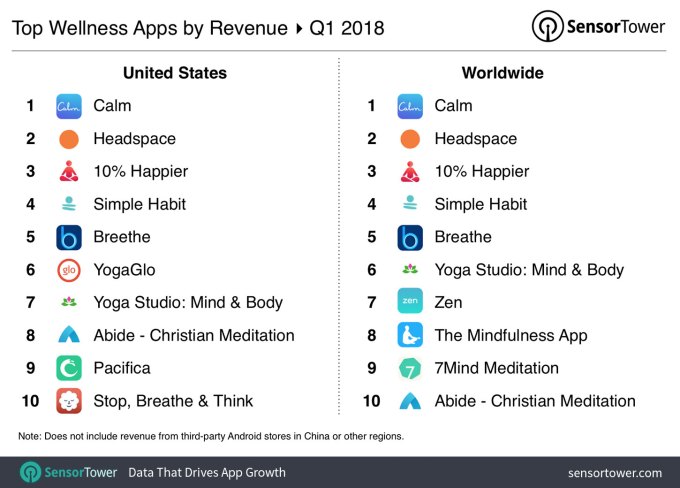
source: techcrunch.com
Self-improvement apps statistics via Market Watch
- U.S. consumers spent $32 million on self-care mobile apps (Calm, 10% Happier, Headspace etc) in both the Apple Store and Google Play in the first quarter of 2018, up 40% YoY;
- 75,000 people download Calm each day, and the app’s downloads have more than doubled in the past year, from 15.2 million in December 2017 to 37.2 million in December 2018;
- American Airlines now features Calm on its boarding videos and in-flight entertainment systems;
- 10% Happier has more than tripled its number of subscribers from 2017;
- Headspace currently has just under 40 million downloads, with well over one million paid subscribers;
- More than 300 companies, including Google, LinkedIn, GE, Adobe, Genentech and Unilever, are offering Headspace to employees as a health and wellness benefit.
![]() Learn more: The Gaming Industry – No longer a child’s play
Learn more: The Gaming Industry – No longer a child’s play
Here are the best self-improvement apps of 2018 by Google
- Mimo. Learn to Code;
- Drops: Learn 33 new languages;
- 10% happier: meditation & sleep;
- Keep trainer: workout trainer & fitness coach;
- Masterclass: learn how to cook, sing, act and more.
Apple identified self-care as the app trend of 2018 with apps like Fabulous, Shine, Calm, and 10% happier leading the trend.
Have you joined the self-improvement movement?
Join the Conversation
We’d love to hear what you have to say.
Get in touch with us on Facebook Group and Twitter.
6 Factors Influencing Customers’ Buying Decisions (1)
Influencing customers’ buying decisions is what marketing is all about. Knowing what makes your customers tick and what factors weigh in on their decisions to buy is the Holy Grail of all marketers.
If you want to learn more about what factors influence your customers’ buying decisions, this article is for you.
Are you looking to reach more customers?
Join BRAND MINDS 2023 and learn how to generate more revenue using digital marketing from Digital Marketing Expert Neil Patel.
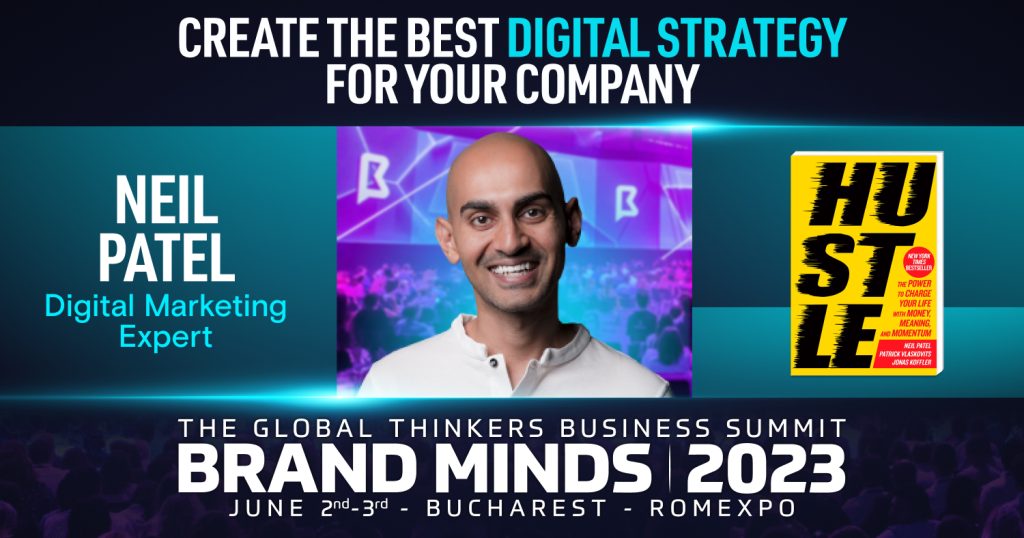
6 factors that influence your customers’ buying decisions
1. Reviews
In 2017 Spiegel Research Center conducted research with the purpose of finding how reviews have transformed the way consumers make purchase decisions – How online reviews influence sales.
The research found that 95% of shoppers read online reviews before making a purchase which makes reviews a powerful form of consumer engagement.
They also found that reviews influenced customers’ buying decisions depending on the following factors: the price of the product, degree of uncertainty or risk involved in the purchase, average star rating, presence of negative reviews, and the number of reviews.
Reviews influence customers’ behaviour as follows:
![]() Displaying reviews can increase conversion
Displaying reviews can increase conversion
The purchase likelihood for a product with five reviews is 270% greater than the purchase likelihood of a product with no reviews
![]() Reviews impact sales more for higher-priced items and for higher-consideration items
Reviews impact sales more for higher-priced items and for higher-consideration items
When the price is higher, there is more risk involved in the consumer’s decision. Having more information via reviews helps mitigate that risk;
![]() Negative reviews establish credibility with 82% of shoppers specifically seeking them out;
Negative reviews establish credibility with 82% of shoppers specifically seeking them out;
![]() Initial reviews have the greatest impact
Initial reviews have the greatest impact
Nearly all of the increase in purchase likelihood occurs within the first 10 reviews, and the first five reviews drive the bulk of this increase. Higher-priced items need at least five reviews to see the greatest conversion impact, whereas lower-priced items only need 2-4 reviews to see a significant impact.
![]() Purchase likelihood increases by 15% when consumers are exposed to reviews written by a verified buyer vs. an anonymous review.
Purchase likelihood increases by 15% when consumers are exposed to reviews written by a verified buyer vs. an anonymous review.
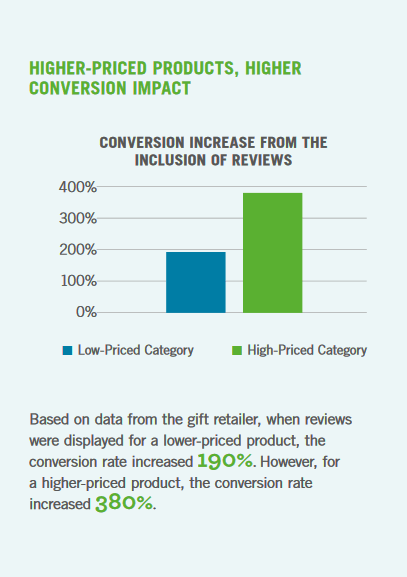
source: How online reviews influence sales
2. Brand familiarity
If you are a search marketer you are striving every day to keep your brand visible on the Google Search Results Page. I’m sure you are familiar with the following saying: The best place to hide a dead body is page 2 of Google. That’s another way of saying that you need to have your brand or company appear on the first page because no one has the time nor the patience to go further to page two or three.
Additional reading: Learn how to rank 1st in Google search results.
The Secret Life of Search is a study based on eye-tracking over 400 search journeys across more than 40 search terms. This study set out to discover how consumer search behaviour has been evolving in recent years and offers a series of interesting and surprising insights.
The first insight is that brand familiarity won more clicks on Google.
![]() 82% of respondents opted for a brand they were familiar with as their first choice, across a wide range of sectors.
82% of respondents opted for a brand they were familiar with as their first choice, across a wide range of sectors.
![]() 47% of these respondents explained their options by being past or present customers of the respective brand.
47% of these respondents explained their options by being past or present customers of the respective brand.
![]() An overwhelming majority of first choices, especially for younger searchers, are driven by ‘off-page’ factors – familiarity with the brand through experience or advertising.
An overwhelming majority of first choices, especially for younger searchers, are driven by ‘off-page’ factors – familiarity with the brand through experience or advertising.

source: Secret Life of Search
3. Customers’ emotional state of mind
What is the customers’ emotional state of mind when they go shopping?
Various reports found that retail therapy – shopping used as a form to relieve stress – is real and is practised by a large percentage of customers.
Here is the stress-shopping behaviour broken down by age:
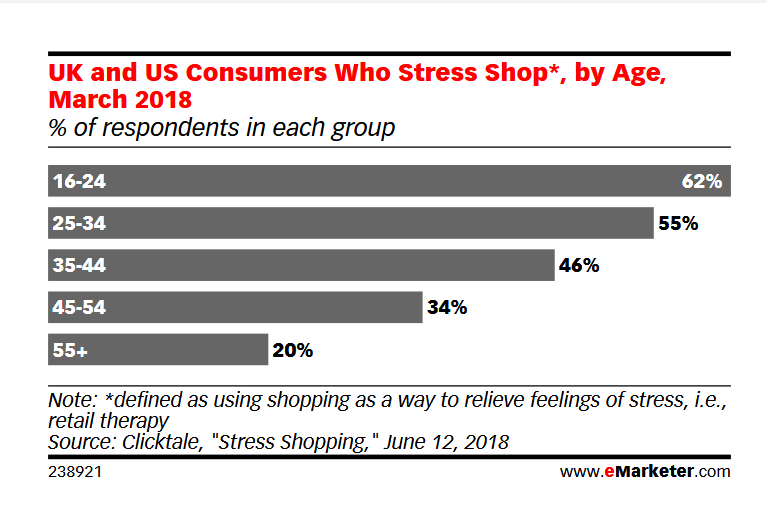
Frustration impacts the customer’s buying decision negatively.
The following stress factors are driving customers away from your website or shop and into the arms of your competition:
![]() Poor customer service online and offline;
Poor customer service online and offline;
![]() In-store shopping was considered more stressful than online;
In-store shopping was considered more stressful than online;
![]() In online shopping the biggest frustration is caused by too many ads (53%);
In online shopping the biggest frustration is caused by too many ads (53%);
![]() Re-entering information during checkout;
Re-entering information during checkout;
![]() Transactions that took too long (22%);
Transactions that took too long (22%);
![]() eCommerce sites that loaded too slowly (81%).
eCommerce sites that loaded too slowly (81%).
Here are the factors that place your customers in a better state of mind thus contributing to increased sales:
![]() A fast-loading site (94%);
A fast-loading site (94%);
![]() Quality of the website experience (61%);
Quality of the website experience (61%);
![]() Quality of the physical store experience (52%).
Quality of the physical store experience (52%).
Additional reading: 6 factors influencing customers’ buying decisions (part 2).
Join the Conversation
We’d love to hear what you have to say.
Get in touch with us on our LinkedIn Group, Facebook Group or Twitter.
How to evaluate a startup company for investment – 5 tips
If you are an investor looking for a startup company to invest in, this article is for you.
It is no secret that investors have a hard time finding good investments. With large sums at stake and a constantly shifting market, investors that do not try their best to avoid miscalculations will experience a loss of capital. Beyond the initial difficulty of finding a credible source of startups to invest in and how to go about it, the biggest question investors ask themselves is “how do I know this investment is right?”.
Indeed, how does anyone know if their decision is the right one or not? There are certain indicators that allow seasoned investors to avoid making such costly errors. While some investors simply follow their gut, the majority are certainly much keener to do (extensive) research before making any decision.
Blindly trusting what is presented to you when it comes to investments is, to say the least, unwise, especially when considering that up to 90% of startups fail, and of those that do succeed, many take a long time to see profit. For most investors, this small and far-off goal does not produce significant enough ROI to mitigate the risks involved in the first place.
As such, investors need to be completely sure before they make the investment.
The question of how to evaluate these startups
Fortunately for you, there are several ways in which this can be done. Don’t be afraid to ask your prospective the tough questions, remember, it is your money on the line. Startups require capital, and as competition for investors is cut-throat, they are willing to provide all the information an investor may need.
Following these 5 tips could be the difference between making money and losing what you thought was a sure-shot investment.
1. The Founding Team
The world’s best investment companies are the ones that are extremely selective in the startups they invest in. Those chosen startups have only attained such investment through the perseverance of a strong team. A strong founding team is the first thing an investor should look at when considering a startup.

The leadership of a startup forms the culture, discipline and work ethic of that venture. While a new or innovative concept will be necessary to win over customers, it cannot be denied that the hard work of the founding team directly correlates with the success of the firm. The way the idea or business model grows and develops depends on the core team that starts it all.
As an investor, you have to look for the passion of the team as much as the integrity of the project. Teamwork is also an important factor determining how well the startup functions. Beyond this, how experienced are the founders? Are they new to business in general, or have they already owned or operated successful businesses? This is a qualitative measure of how likely a startup is going to be successful before they have even launched.
2. The overall returns on the investment

During pitch presentations, make sure you ask the startups for accurate projections of annual revenues and profits, implying the kind of return on investment (ROI) you can expect. Many startups are unrealistic about their expected returns because they are trying to please potential investors.
Instead, make sure to do your research and request the company’s previous balance statements. You’ll be able to catch all the overpromises they have made due to inexperience easily.
Investors, however, should not let a lower ROI be the reason they reject a startup, as this must be judged on a case by case basis. A pragmatic approach means that the ROI you are presented with will be closer to the one you receive. As an investor, you also accept that even for a successful startup, ROI starts out small and grows gradually over time. If spent correctly, the investment will allow the startup to expand, leading to greater returns in the long run.
3. The competitive advantage of the investment
Investors often worry about the idea that a startup has immense competition in the market. They often forget that this means the startup has potential as they have tapped a potential market segment. On the other end, other investors also tend to look out for promising startups so they could get their hands on them first.

Competition to invest in a startup only raises its credibility as a desirable investment opportunity. Since startups sign a contract for a set number of years, the investors would benefit from them until the contract is renewed or turns void.
A venture should not be avoided just because a high degree of competition restricts its entry into the market. Instead, investors should have a more flexible approach, and potentially allow new ventures the chance to carve their own paths. Several companies have risen to prominence by virtue of the fact that their investors had faith in the company’s capability.
4. Market momentum and demand
The product’s position in the market is a strong indicator for investors. Companies have to build a certain momentum within the market in order to attract investors. This momentum can be crucial because it helps drive the company to the next level.
The job of an investor is to determine whether the next level is achievable with their help. If achieved, the company will not only evolve and produce substantial ROI for the investor but establish itself in the market. If however, the company fails to do this, the investor might lose out because of a bad deal.
Check the overall growth of the company and how it has built itself to the point that its founders are pitching to you.
Check through past financial reports and even ask for profit and loss statements to see overall growth.
The kind of momentum built in the market is itself a key performance indicator of how well the company is to perform in the years to come.

5. Business mission and values
The mission is the one thing that the investor cannot change. For an investor, it is the mission of the company that can make the final decision. Some investors can be so impressed by a venture’s mission that they may go with the investment blindly, yet these are rare exceptions and is in general not recommended.

The mission the venture puts forward will also inform the culture of the startup. The investor, therefore, has to determine whether the mission aligns with their beliefs. Startups usually describe their mission in their pitch, though if they fail to do so, ask. Failing to mention the business mission is one of the most common mistakes made by rookie startup CEOs, and it is important when making your decision.
The way they speak about it speaks to the emotional value the company’s owners stake in their business. An entrepreneur who is highly emotionally attached to the mission is likely to devote more of their time and energy to the project, and this should be considered when determining whether the startup is worth taking the risk for.
Be aware, however, that a passionate entrepreneur can also be a stubborn one. Make sure the culture of the startup is in line with your own belief system. Having clashes after the deal is done can prove to be harmful to both parties.
[bctt tweet=”Taylor Ryan (CEO@Klint Marketing) writes about 5 tips on how to evaluate a startup company for investment” username=”brand_minds”]
Why invest in a startup?
Startups are full of energy and potential that can greatly benefit from a little injection of money. Investors often look for promising startups in schools, competitions and online because they recognize the kind of potential they have to drive change in the market. They are capable of disruptive innovation, thereby changing the overall landscape of the market, as Apple once did.
Investors are always on the lookout for promising entrepreneurs with their own companies who display the kind of leadership qualities that can create success. Startups are also a great way of investing in something with the potential for huge returns.
Key Takeaways
- Is the founding team strong?;
- Look for the passion of the team as much as the integrity of the project;
- Request the company’s previous balance statements;
- Judge a lower ROI on a case by case basis;
- A startup with competition in the market means they have tapped a potential market segment;
- Determine whether the startup’s next level is achievable with your help;
- Check the overall growth of the company;
- The kind of momentum built in the market is itself a key performance indicator;
- What is their mission?
- The mission will also inform the culture of the startup;
- Does the founding team have an emotional stake in their business?
Conclusion
Evaluation of a startup is a necessity, as you can never be sure what the startup will bring to their pitch. The business can thrive with the investors help or equally drown in debt in a few years. No matter what happens, an investment is never 100% guaranteed. An investor is always gambling on whether or not an investment will work out.
Investing in startups might not see an immediate ROI, but can be extremely profitable in the long-run. Some of the greatest investors of all time started by investing in small startups that at that time were only worth a couple of hundred dollars. Now, companies like Apple, KFC and even Google are worth a million times more than their initial evaluations.
In time, the kind of qualities that you evaluate the company on will reap the fruits you deserve. The rest requires patience and hope that whatever happens, happens for the better.
Join the Conversation
We’d love to hear what you have to say.
Get in touch with us on Facebook Group and Twitter.
Alice, the World’s First All-Electric Aircraft
The future will be sustainable. Many fuel-powered industries are shifting towards alternative solutions. Tesla manufactures electric cars, startup Bound4Blue harnesses wind power to change the shipping industry and Seaborg Technologies designs green nuclear reactors.
Let’s find out how air travel is taking up the sustainability challenge!
Look! Up in the sky! It’s a bird! It’s a plane! It’s Superman!
No, it wasn’t Superman visiting this year’s Paris Airshow, but Alice, an aircraft which might as well have received the same reaction from the show’s attendants because just like the beloved American superhero it’s something the audience has never seen before – the first all-electric aircraft.

Alice Commuter / flightglobal.com
The future of air travel is here and its name is Alice
Alice Commuter is the first all-electric aircraft designed by Eviation Aircraft, an Israeli planemaker company.
Eviation’s mission is to bring on-demand transportation to the next stage by enabling emission-free air travel for the price of a train ticket.
The company is a member of the NASA, FAA and GAMA electric aviation committees which makes it a key proponent in determining the future of the aviation industry.
The company’s leadership consists of a team of entrepreneurs committed to building disruptive solutions: Chairman Aviv Tzidon and CEO and co-founder Omer Bar-Yohay.
Aviv Tzidon holds over 15 patents and is an accomplished entrepreneur. Omer Bar-Yohay is a Physicist with unique high power electric propulsion systems expertise.

Alice Commuter at the 2019 Paris Airshow / ainonline.com
Alice Commuter – State-of-the-art Technology
- Designed to take 9 passengers up to 650 miles at a cruise speed of 240 knots;
- Technical features: cruise altitude – 10,000’, energy pack Li-lon – 900 kWh, wingspan 16.12m, length 12.2m, MTOW 6,350 kg;
- Built from the ground up to be electric;
- At the heart of the design process is the passenger experience;
- Bigger cabin than a normal turbo-propelled aircraft;
- All-electric propulsion powered by batteries;
- Cutting-edge composite body frame to achieve lightness;
- Unique propulsion system: wingtip and tail propellers;
- Slim and slick design;
- High efficiency at cruise;
- Innovation in the fields of airframe design, battery technology and integration, advanced lightweight materials, thermal management and vehicle autonomy.
Benefits
1. Low operating costs
Building an electrically powered aircraft competes on all of the highest cost factors of the operational cost of the plane, fuel & oil and motor reserve.
2. Fast and Comfortable
All composite structure built for electric integration, extreme propulsion & aerodynamic efficiency and flight stability
3. Sustainability
Alice is three ways sustainable as CEO Omer Bar-Yohay said in a recent interview:
- It is economically sustainable because it costs the company only $200/flight hour to operate the aircraft;
- It is environmentally sustainable thanks to its reduced footprint (zero carbon emissions, energy efficient);
- It is socially sustainable – the electric engine is silent.
Awards
Eviation Aircraft received the following awards:
- Gold at the 2019 Edison Awards in the Aerospace Innovation category;
- Winner of the transportation category of Fast Company’s 2018 World Changing Ideas Awards;
- #3 in the 2018 Transportation category of the World’s Most Innovative Companies by Fast Company;
- Named the 2017 Wall Street Journal Live Audience Favorite.
Join the Conversation
We’d love to hear what you have to say.
Get in touch with us on Facebook Group and Twitter.


